Most people visiting Qatar do so for business reasons. However, this is changing as the tiny Gulf state pursues its ambition to become a major player on the regional and international tourism scene by turning itself into a centre for meetings, sports, culture, and leisure.
Just how confident the Qatari authorities are about attracting huge numbers of future visitors can be judged by the size of Doha’s new international airport, due to open next year. Initially it will cater to 24 million passengers, but further expansion will increase the number to 50 million after 2015. The airport has been designed specifically for the Airbus A380 twin-deck super jumbo, the biggest passenger aircraft ever built.
The World Travel and Tourism Council (WTTC) predicts that tourism in Qatar will grow by around 13 percent this year and double over the next 10 years – the fastest growth rate in the industry in the Middle East. The Qatar Tourism Authority (QTA) is targeting a 20 percent increase in the industry over the next five years.
And that’s ahead of Qatar’s hosting of the 2022 FIFA World Cup, an event that will showcase the country to a TV audience of billions across the globe.
The Qatari government is eager to diversify the economy away from overdependence on hydrocarbons and believes that tourism has enormous potential in this regard. This is supported by the industry’s rising contribution to the economy, both directly and indirectly – estimated by the WTTC at $5.5 billion last year, and expected to reach $11.25 billion in 2022.
In 2011, European tourist arrivals were up by 15 percent, and GCC visitors grew by 50 percent
Tourism has great potential to diversify Qatar’s economy away from hydrocarbons. Already, the sector contributes directly and indirectly, some $5.5 billion
|
Qatar has invested significantly in the development of its tourism and transport infrastructure, building new hotels, resorts, and cultural centers, and the pace of investment will accelerate in the run up to the World Cup. The government plans to spend some $20 billion towards the development of tourism projects, and $65 billion on infrastructure to facilitate tourist movement during the event, including a Metro system for Doha.
Meanwhile, Qatar has been busy broadening its tourist appeal. It has already established a reputation for successfully staging large-scale events – particularly international sporting tournaments, attracting large numbers of tennis, golf and athletics fans. Last year, it staged the AFC Asian Cup, and for the mega-championship of 2022 it is building nine spectacular new stadiums.
Cultural attractions in Qatar range from museums focusing on Arab and Islamic heritage and art, to the Waqif Art Centre, Katara Cultural Village, and the iconic Qatar National Convention Centre. Shoppers can head for the traditional souks or buy leading international brands in sleek modern malls.
Business tourism accounted for 72 per cent of the total number of tourists who arrived in 2011, and Qatar is firmly on the map as a destination for meetings, incentives, conventions, and exhibitions (MICE) tourism. Since opening in December last year, Qatar National Convention Centre alone has attracted more than 136,000 visitors hosted to over 200 events, including major international conferences.
Overall visitor numbers are still relatively modest compared with some other Gulf nations, but the upward trend is unmistakable and Qatar is determined to grab a major share of the lucrative regional tourism market.
Last year was the most successful yet. According to the QTA, 2011 saw an increase of around 50 percent in visitors from the GCC region, compared to 2010, with some 845,600 arrivals. International tourism figures were also impressive, with a 12 per cent increase. Asian tourists accounted for 58 per cent of the total, while tourism from European countries was up by 15 percent.
Doha’s hotels enjoyed a record year in 2011, with revenue from four and five star hotels exceeding $1.3 billion.
The number of hotels in Doha has doubled since 2010 to around 12,000. Eight new hotels opened last year and more are under construction. Famous international brands like St. Regis and Hilton have recently joined brands like W, Four Seasons, Marriott, and Sheraton in the capital.
Hotel occupancy rates across the country peaked at 85 per cent during the recent Eid Al Adha holiday, held at the end of the Hajj, the annual Muslim pilgrimage to Mecca. With more than 10,300 visitors arriving from all GCC countries for the celebrations, Qatar appears to be on track to become one of the main tourist spots for GCC citizens.

0 COMMENTS